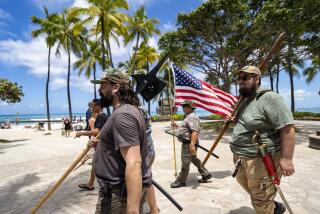Far From the Islands, Hula Holds Sway
She’s poised on dashboards everywhere, that miniaturized “exotic” beauty in a grass skirt and coconut bra, swaying her hips and smiling. Ever since Hollywood discovered hula and the Islands’ tourist industry took off, the dance form has had a strong association with lounge acts, Hula-Hoops and hotel luaus--just another brand of kitschy entertainment for travelers on their way in and out of paradise.
The reality, of course, is that hula has an ancient history. For traditional Hawaiians, it’s a sacred ritual brought to the Islands by Hi’iaka, the sister of Pele, the volcano goddess. And even as a mostly secular folk dance, it is viewed by practitioners as an authentic cultural expression: a tribute to Hawaiian history, mythology and aesthetics, not a travel poster gimmick.
“Hawaiian people feel stereotyped all the time,” says Terry Liu, a folk art specialist who studied in Hawaii. “It hurts them that people think that hula is just sort of a sexual dance or something just to entertain tourists, when in fact this beautiful dance [is] a tremendous art [practiced and taught] by great masters.”
Liu, who now works as a folk and traditional arts coordinator at the Public Corp. for the Arts in Long Beach, is one of the organizers of “Ohana--We Are Family,” a showcase of hula designed to erase a few of those misconceptions and celebrate deeper Hawaiian values. This afternoon at the Carpenter Performing Arts Center in Long Beach, three local hula halau--Hawaiian dance schools--present traditional and modern dances, each school emphasizing its own interpretations and style.
“Not that many people know that Hawaii has its own culture, its own language, arts and crafts, philosophies, way of life,” says Keali’i Ceballos, the head, or Kumu hula, of Hula Halau o Keali’i o Nalani, an L.A.-based hula halau.
“People think Hawaii’s all sand and fun, which is fine because it is. But it also has a culture. I feel it’s my duty to do what I can to share the culture with people here,” Ceballos says.
‘Look up at the evening sky, up 2, 3, 4. . . . Move your palms as you gently lift more of the night.”
Ceballos, a muscular 37-year-old, is addressing a roomful of barefoot dancers a few weeks before the Ohana performance. They are all in practice gear: black leotards with elastic-waist skirts for the women and shorts for the men. It’s a rainy Sunday afternoon at the Westside Academy of Dance, and in this case, the night sky is made of hanging fluorescent lights and unfinished wooden rafters.
The passage in question is paying tribute to the bounty of the Islands, but for hula dancers thousands of miles away from the land of volcanoes and leis, some of whom have never set foot on Hawaiian soil, it requires some imagination.
“I say, hey, this song talks about the ocean spray of this particular area of Hawaii,” Ceballos will explain to his dancers, “but think of the ocean spray on Santa Monica beach, it’s the same wonderful feeling.”
Kumu hula Ceballos was himself born in L.A. of a Hawaiian mother, who taught him how to hula--traditionally, the dance is passed generation to generation through the family. His English name is Bernard, and his day job is teaching ballroom dancing (he’s a former champion). He started his hula halau in 1991. “Ballroom dancing is my occupation; hula is my love,” he says.
Working with a roomful of Angelenos--some with Hawaiian blood or background, many without--to perpetuate and embrace Hawaiian culture seems completely natural to Ceballos. He’s less concerned with ethnicity than with getting his students to understand and express the poetic content of hula’s story lines.
He hums a passage of the Ohana program finale, then translates the song--written by a homesick Hawaiian living on the East Coast--for his dancers, most of whom do not speak much Hawaiian.
“You’re searching for your home--Haa-waaa-iiiii,” he says in long, reverential syllables. “You’re looking for your place on Earth.
“Just by studying hula and Hawaiian culture you are Hawaiian at heart; this melee [song] does apply to you. You don’t have to have blood to be Hawaiian, you are Hawaiian. You love the fact that you are Hawaiian,” he calls out across the room in a voice as smooth and sweet as coconut milk, his lines straight from a self-affirmation cassette.
“The gentleman who wrote this just had to realize that home is in his heart,” he says.
The dancers take it from the top.
“Tell the story! 1, 2, I am Hawaiian! 3, 4,” he shouts cheerfully.
Every movement in hula dance is an expression of storytelling. As one of Ceballos’ well-schooled students put it: “Hula isn’t just about wiggling.”
In broad terms, hula dances are divided into two styles. The traditional ancient hula kahiko--created to honor gods and goddesses--was forbidden by the missionaries who colonized Hawaii in the early 1800s. While it continued in secret, hula kahiko wasn’t revived publicly until the 1970s. In the 1860s, however, Hawaii’s last king, Kalaka’ua, brought back at least the motions of hula, and the modern style, hula’auana, was born. It uses the familiar hip swaying, footwork and arm and hand gestures, removing the sacred element from the dances. And the ancient implements used in hula kahiko, such as the ipu stick and the gourd rattle, were replaced by the steel guitar and the ukulele. Modern hula’auana’s mostly secular songs--influenced by everything from jazz to opera--employ Western harmony and melody and celebrate legends, nature and human emotions.
Understanding the Hawaiian language--like the hula itself, the language was outlawed by the missionaries and has had to be revived--is key to understanding the ka’ona, or “hidden meanings” of the songs, their symbolism and metaphors.
“You might use your hands to show the form of flower, but a person who knows the language can say, ‘Oh, he’s talking about children,” explains Eddie “Kunewa” Mook, 57, a hairdresser who runs the Glendale-based school Hula Halau o Kamuela’Elua, another of the schools performing today.
Most schools practice both ancient and modern styles. Sissy Ka’io, kumu hula of the Carson-based Hula Halau o Lilinoe, which will also be performing today, claims descent from a line of priests and priestesses linked to Pele. Her halau favors the ancient style of aiha’a, a highly physical, energized form danced low to the ground, knees bent.
Ka’io, who is an accountant with Toyota when she isn’t teaching hula, says that the differences between modern and traditional styles might not be clear to many viewers.
“The dance doesn’t take long to learn,” she says, “but it takes a hula dancer years and years to [really] dance the hula, because it’s a journey. But the average person looking at it probably wouldn’t understand its depth, because it’s so connected to our religion.
“Modern hula doesn’t have the sacredness. There’s not as much restriction, and you can be more creative,” Ka’io says. “Hula kahiko has restrictions but a greater sense of connection [to the past].”
Both the modern and ancient styles of hula will be featured at today’s performance in Long Beach, with the first half invoking the mythology of Pele and the second incorporating new dances. The “homesick for Hawaii” finale, which Ceballos and his students were working on, will put the dancers from all three schools onstage together. And the ka’ona of each of the songs and chants will be explained in detailed program notes and narration with the dances.
But what is most important to the organizers of the event is the theme of the performance: the notion of family. Amy Stillman, a professor of ethnomusicology at UC Santa Barbara and a native Hawaiian (of Hawaiian, Scotch, German and Chinese ethnicity), who is curating the performance, says that the organizers chose the theme of ohana because it gets to the heart of the cultural preservation and communication they all espouse.
“Multi-generational family life and the continuity of family is very fundamental to Hawaiian culture,” Stillman says.
Ka’io echoes the idea: “My style is ohana-based,” she says, “so I teach a lot of families--mothers, sons, brothers, sisters. I use hula to teach the values of the Hawaiian community, which living away from the Islands can sometimes dissipate: to live morally, to have a generous heart--not just the physical part.”
Jane Pang, one of the organizers of today’s event, likens the meaning of hula with the word aloha.
“We throw around aloha, which [means] love, hi, goodbye,” says Pang, a public health nurse of Chinese-Japanese heritage who is married to a Hawaiian and active in Hawaiian Civic Clubs. “But aloha”--and the hula--”really comes with a lot of responsibility, to respect and care for one another--it’s all part of those traditional values that we treasure.”
*
“OHANA--WE ARE FAMILY,” featuring Hula Halau o Kamuela’Elua, Hula Halau o Keali’i o Nalani and Hula Halau o Lilinoe, Carpenter Performing Arts Center, Cal State Long Beach, 6200 Atherton Blvd. Date: today, 4 p.m. Prices: $15-$25. Phone: (562) 985-7000.
More to Read
Sign up for The Wild
We’ll help you find the best places to hike, bike and run, as well as the perfect silent spots for meditation and yoga.
You may occasionally receive promotional content from the Los Angeles Times.






